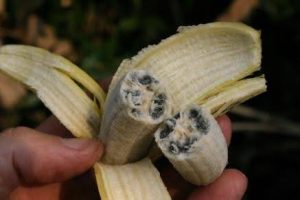Differences in ploidy and the impact to meiosis
Polyploid organisms with even-numbered ploidies (2x, 4x, 6x, 8x) can produce gametes via meiosis with pairs of chromosomes assembling in prophase I as bivalents, or multiples assembling in a higher-order association (e.g. a tetravalent for a tetraploid organism). But cells with odd-numbered ploidies or aneuploidies cannot typically undergo meiosis, since an odd number of chromosomes cannot be evenly divided during meiosis I.

Cells with odd-ploidies can, however, undergo mitosis, and so we do see examples of viable monoploid and triploid organisms – they just aren’t fertile for sexual reproduction.
An example of a triploid organism is the most common variety of bananas seen in U.S. grocery stores. Wild bananas are generally smaller than the Cavendish variety found in grocery stores. Wild bananas also have seeds, as shown in Figure 16.
The Cavendish variety is larger and triploid. They most likely arose from the fusion of diploid gamete with a haploid gamete of a wild banana like the one in Figure 15. But because they are triploid, they are sterile: they do not undergo meiosis, and they are therefore seedless. Cavendish bananas are propagated from suckers that grow out of the base of a banana plant. These suckers are genetically identical to the parent because they grow from mitotic cell divisions rather than meiosis. About 47% of bananas grown worldwide – and about 99% of bananas produced for export – are Cavendish bananas. And they are all genetically identical[1].
Some trivia! Some seedless fruits have similar genetics to the banana: they’ve arisen from the fusion of gametes with differing ploidy, and they cannot undergo meiosis so do not produce seeds. Seedless watermelon is like this. But others, like seedless grapes, are different. Seedless grapes have a disruption in either meiosis or seed maturation, but it is due to different underlying genetic mechanisms unrelated to ploidy.
Odd-number genomes are rare in animals, but an exception is seen in many species of bees, wasps, and ants, which use ploidy to determine sex. In these animals, males develop from unfertilized eggs and are haploid (or monoploid). Females develop from fertilized eggs and are diploid. Male cells cannot undergo meiosis since there are no chromosome pairs. Instead, sperm are produced via mitosis. Diploid female bees use meiosis to produce eggs.
- World’s Bananas Are in ‘Imminent Danger’ of Disease. Newsweek https://www.newsweek.com/worlds-bananas-are-clones-and-they-are-imminent-danger-publish-monday-5am-1321787 (2019). ↵

